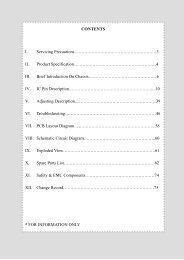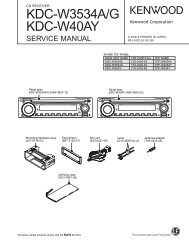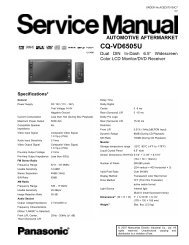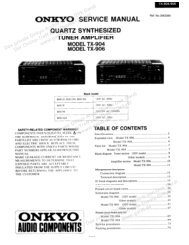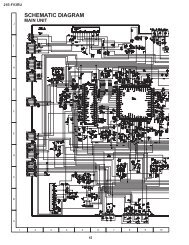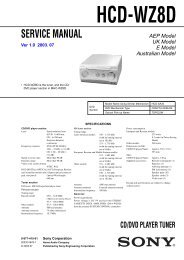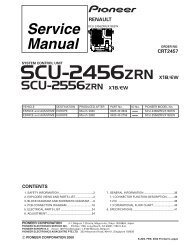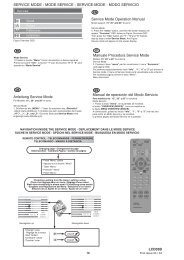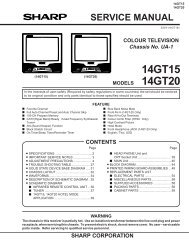Technology of Q 2500 colour TV set
Technology of Q 2500 colour TV set
Technology of Q 2500 colour TV set
You also want an ePaper? Increase the reach of your titles
YUMPU automatically turns print PDFs into web optimized ePapers that Google loves.
<strong>Technology</strong> <strong>of</strong> Q <strong>2500</strong> <strong>colour</strong> <strong>TV</strong> <strong>set</strong>2.2.2 Start-upThe power supply section is started up by anadditional starting circuit. The required voltageis rectified using a diode path in the bridgerectifier. It is fed via resistor R 621 to pin 6 inTDA4605 where capacitor C 622 is thenslowly charged. During this charging phase,capacitor C 637 is charged to 6.6 V on pin 2via an internal IC path. A reference voltage <strong>of</strong>1V that is required during the start-up phaseand later during normal operation is also generatedin the IC.If the voltage at pin 6 reaches 12 V the IC operatesand makes the switching transistorconducting via pin 5. A current flows throughboth the transformer working winding and theswitching transformer drain source path. Duringthis period, magnetic energy is beingstored in the transformer. During this conductivephase, a drain current simulator C 637,integrated in the IC, is charged on pin 2. If theinternal reference value <strong>of</strong> 1 V is reached theIC blocks the switching transistor. The magneticfield in the transformer breaks down andthis induces voltages in the windings.The start-up procedure recommences and thesystem swings/oscillates to normal operation.This is arrived at when a voltage <strong>of</strong> 400 mVhas built up at pin 1.2.2.3 Normal and control operationA static state is <strong>set</strong> in normal operation atconstant load. The operating voltage for the ICis drawn from the transformer winding pin 5-6and rectified with D622. The voltage at pin 6 inthe IC is then 11 V. The control input at pin 1is 400 mV and the duty cycle for the zero passagedetector at pin 8 in the IC is <strong>set</strong>.The switching transistor is controlled with afixed frequency <strong>of</strong> between 20 and 40 kHz,which corresponds to the instantaneous load.If the load changes, the duty cycle at pin 8 inthe IC also changes. The negative edge indicatesto the IC when the energy stored in thetransformer has been dissipated. If the loadincreases, this occurs more quickly and the ICreduces the control frequency. If the load decreases,the control frequency increases. Thismeans that load variations between approx.40 and 260 W and mains voltage fluctuationsbetween 180 and 270 V can be compensatedfor.In order to achieve a higher UB voltage stability,regulation on the secondary side is nowused which influences the primary circuit’s I669 opto-coupler. The I 669 opto-coupler iscontrolled via I 670. The control mechanism isinfluenced via several paths:- With d.c. voltage via R 663- Alternating, by coupling to the R 680 diode.- When not under load, via D 672The operating voltage is <strong>set</strong> with the P662potentiometer. A small resistance here indicatesa high value <strong>of</strong> UB. Correspondingly, ahigh value <strong>of</strong> R means a low value for UB.If UB increases, e.g. due to a smaller load onthe line output stage, UB exerts a strongerinfluence via R 663 at the input <strong>of</strong> I 670. Thisresults in the I 670 cathode outputting asmaller voltage. The photodiode in I 669 receivesmore current through R 665. The pathbetween pin 3/4 <strong>of</strong> I 669 has a lower resistanceallowing for a higher voltage on pin 1 <strong>of</strong>I 611. Component I 611 then regulates outputvoltage until a value <strong>of</strong> 400 mV on pin 1 isreached again. If the value <strong>of</strong> UB becomeslower, then the regulation process is exactlythe inverse <strong>of</strong> that described here.Via D 680, R 669 and C 669, ripple voltagecomponents are coupled into the regulatingcircuit. In particular, this branch prevents a low50 hz ripple voltage arising on UB. With 60 hzsignal sources (NTSC, PAL 60 Hz or VGAoperation), this would result in humming interferencein the picture.Document Q <strong>2500</strong> 16 © Loewe ProCollege



